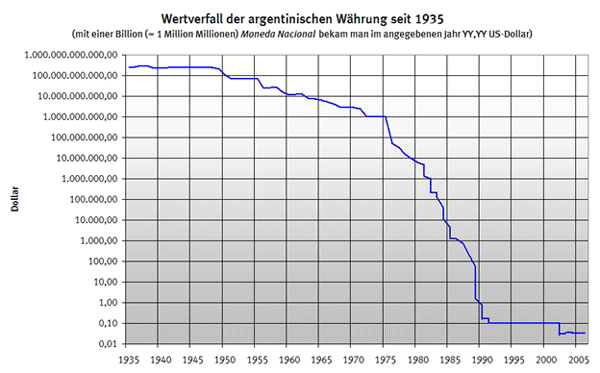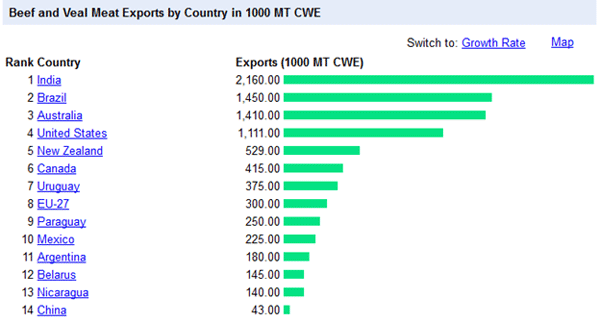Argentina: A Lesson in Chaos
At the turn of the 20th century Argentina was one of the richest countries in the world, due primarily to its vast and fertile farmlands. In 1913, GDP per capita was about equal to those of France and Germany and close to that of the US. By 1950, though, Argentina's GDP per capita wasn’t even half that of the United States. (You can read a short, graphic history of the economic chaos that has been Argentina from the 1930s on at http://en.wikipedia.org/wiki/Economic_history_of_Argentina.)
Currency values plummeted. Inflation reached 5,000% at one point in the 1970s. Prices increased by a factor of 20 billion from 1975-1991 – over 300% per year. In 1983, at the urging of the IMF, a new peso was introduced at a value of 10,000 to one of the old pesos. Ouch. And that was just the beginning!
The Peronist government of Menem, elected in 1989, made a deal with the IMF, which promptly collapsed, leading to a rapid 12,000% inflation. On January 1, 1992, a new monetary reform replaced the austral (the name of the currency at that time) with the new peso at a rate of 10,000 australs for one peso. Another 10,000-fold devaluation – twice within ten years! The peso was now fixed to the dollar.
The following chart shows the value of the peso in dollar terms since 1936. The numbers are in German, which makes the chart just too ironic not to use. Note that each one of the horizontal bars represents a devaluation of 90%! (The vertical axis is a log-10 scale.)

I first came to Argentina in 1993. The country had just emerged from economic chaos. Real per capita income had dropped by 20% in the previous 20 years. But even with the chaos, the restaurants were busy at 10 PM, when Argentines like to eat!
Over the succeeding years, with a fixed dollar exchange rate, some industries could not compete and trade deficits grew. As in Greece today, the only way to create a fiscal balance was labor-price devaluation, which was decidedly unpopular. So Argentina went off the dollar standard, and the value of the peso dropped by 50%.
In December 1999 Fernando de la Rúa was inaugurated President,
seeking assistance from the IMF shortly thereafter. In March 2000, the
IMF agreed to a three-year $7.2 billion stand-by arrangement with
Argentina, conditioned on a strict fiscal adjustment and the assumption
of 3.5% GDP growth in 2000 (actual growth was 0.5%). In late 2000,
Argentina began to experience severely diminished access to capital
markets, as reflected in a sharp and sustained rise in spreads on
Argentine bonds over U.S. Treasuries. In December, the de la Rua
government announced a $40 billion multilateral assistance package
organized by IMF. The uneven implementation of fiscal adjustments and
reforms, a worsening global macroeconomic environment, and political
instability led to the complete loss of market access and intensified
capital flight by the second quarter of 2001. Argentine debt, held
mostly in bonds, was massively sold short and the government found
itself unable to borrow or
meet
debt payments. [Shades of later Greece!]
In December 2001, a series of deposit runs began to have a
severe impact on the health of the banking system, leading the Argentine
authorities to impose a partial deposit freeze. With Argentina no
longer in compliance with the conditions of the expanded IMF-supported
program, the IMF decided to suspend disbursements. At the end of
December, in a climate of severe political and social unrest, the
country partially defaulted on its international obligations; in January
2002, it formally abandoned the convertibility regime. (Wikipedia)
The economic and political crisis that followed was arguably the
worst since the country gained its independence from Spain in 1816. By
the end of 2002, the economy had contracted 20% since 1998.Over the
course of two years, output fell by more than 15%, the Argentine peso
lost three-quarters of its value, and registered unemployment grew to
25%. Income poverty in Argentina grew from an already high 35.4% in
October 2001 to a peak of 54.3% in October 2002.My friend and Uruguayan business partner Enrique Fynn tells stories of coming to Buenos Aires and hearing new prices being announced hour by hour over a public address system in a grocery store. He had dollars, which bought him lots of goods to take back on the ferry.. People who were prescient and had money were able to buy apartments in BA and land in Argentina at what can only be called fire-sale prices.
Argentina on Sale
I remember coming to Argentina about three years ago. I thought prices in Buenos Aires were high – the peso was about 3.50 to the dollar. When I visited again last November, prices were “reasonable” by my travel standards, and here in Cafayate I found good value. I have friends who are building homes here much more cheaply than they could in the US. And the quality is high; there are some real craftsmen here. Their stonework is exquisite.
I was in Buenos Aires last Friday. The official exchange rate is now 5.50 pesos to the dollar. The street price is 7.75, on its way to 8. But the largest bill is a 100-peso note, which is now worth less than $13. Using a credit card costs at least an extra 10%, if not 20%; but the prices you are quoted for using a credit card instead of cash are higher to start with, before the surcharge, so using a card ends up costing you about an extra 40%. But you need to carry a lot of cash if you want to buy anything expensive. (Be very careful if you do not know your way around. I am told there are lots of counterfeit bills passed off on tourists. Not that I exchanged anything, of course this is all theoretical, for illustration purposes.)
I was staying in the Recoleta area, which is one of the most expensive areas of the city and a wonderful place to while away a day or two.
But things were cheap. A simple lunch for two on a fashionable street was around $15. We had a fabulous meal at a restaurant we stumbled on, called Sirop Folie. (I will go again!) It would have been $150 at a comparable place in Dallas or NYC (or Europe), but it cost us just $50, including tip. I left my computer mouse in Dallas but was able to pick one up for $6. Vegetables and cheeses were around half what I am used to paying in Dallas. I began to “shop” in order to look at prices. By US standards, Argentina is on sale. And this was in the high-rent district.
On the way to Cafayate, there were signs on the road for chicken dinners for the local trade priced at $2 equivalent. Our dinner last night for two was less than $40 (all in) at what is considered one of the better local restaurants, Vinas de Cafayate (fabulous menu!). The place was packed by 10 pm, as I was leaving. So Argentina seems inexpensive today. Not a definitive study, admittedly, but the trend is clear.
President Kirchner is again experimenting with price controls. (Peron infamously tried to control even restaurant menu prices in the late 1940s – you’d think he would have known better). The last time price controls failed was in 2005. Now, Argentina has limited beef exports in the futile hope that doing so will drive down beef costs. All that has happened is that cattle herds have been reduced and exports are down. Similar export controls to try to keep bread prices down have seen wheat production fall.
Brazil has seen its cattle exports explode in 20 years, while Argentina’s have not grown at all as the government tries to control production and export prices. Argentina used to be the world’s largest beef exporter, but Brazil now has a herd almost four times the size of Argentina’s. How many jobs have been lost to Brazil? One long-time exporter says, “There are developed countries, emerging countries, and then there's Argentina.
Want to see something sad? An illustration of what governments can do to an industry by trying to control it? Look at this chart. Argentina is now down at #11. Tiny neighbor Uruguay exports twice the beef and veal.

The government is committed to a path of monetization. Inflation is denied by government statisticians, but it is at about 30% and rising. While the government is putting pressure on grocers to maintain prices, which always leads to shortages, as of this morning you can still find anything you want at the local equivalent of a well-stocked Hypermart.
retirado de http://www.investorsinsight.com/blogs/thoughts_from_the_frontline/default.aspx
Nenhum comentário:
Postar um comentário